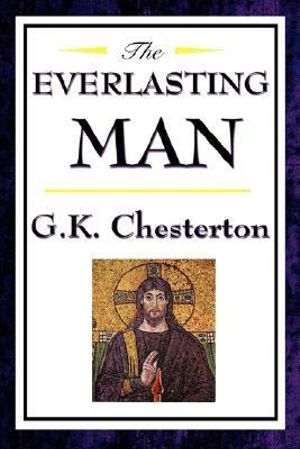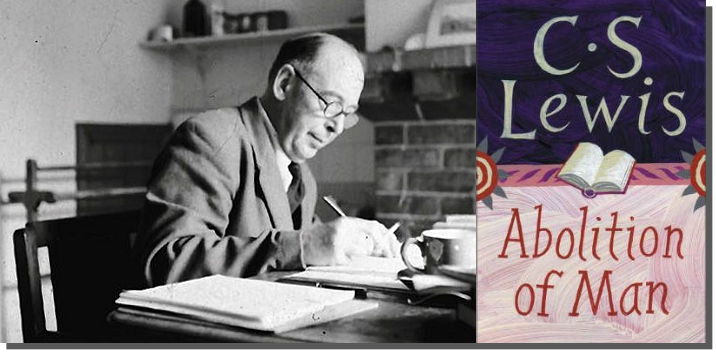Garry Nieuwkamp, a frequent contributor to the pages of The Defendant, compares two classic works by Chesterton and C.S. Lewis.

Reading the odd Chesterton book can be the cognitive equivalent of taking one of those rides at Dreamworld with names like ‘The Zinger’ or ‘The Beast’, where you get thrown around like a damp cloth in a tumble dryer only to be deposited on your feet at the end, not sure which direction is up.
Oftentimes you want to say, if you could: “Gilbert… slow down a bit, mate!”
The Everlasting Man is one such book. It was written as an antidote to H.G. Wells’ The Outline of History: The Whole Story of Man. The whole temper of Wells’s book is “of a reaction: sulks, perversity, petty criticism”. Chesterton has written not only a corrective but battles to keep alive the wonder and mystery of a world that is “stooping and hiding a face”.
The Everlasting Man is Chesterton’s response to what scientists leave out when they try to explain the world.

At the dawn of humanity, the caveman is already in dialogue with God. The scientist sees smudges on the cave wall and reaches for Darwin. For the scientist, man is just a “trousered ape”, to use C.S. Lewis’s expression.
In a beautiful juxtaposition, Chesterton sees another cave wall with a caveman, who had “traced strange shapes of creatures, curiously coloured, upon the wall of the world”. The pictures he created “had come to life”.
The Incarnation makes all the difference to the world. It is a blow that has broken “the very backbone of history”.
According to Joseph Pearce in C. S. Lewis and the Catholic Church, Lewis encountered Chesterton’s writing for the first time while he was recuperating from trench fever during the war. On reading Chesterton, Lewis wrote, “I did not know what I was letting myself in for”.
Christian outline of history
When he read The Everlasting Man in the 1920s, it had a bewildering influence. He could see that a Christian outline of history made sense, but he still could not see that ‘everything was stooping and hiding a face”.
The materialist cry that there is no “in front”, there is only the back of the world, was orthodoxy. The scientific and industrial revolutions brought widespread success, but also carnage; enchantment dying somewhere in the Somme “like a devil’s sick of sin”.
The prevailing view in the academy was that only the sciences give us knowledge. That left all sorts of claims outside of the plausibility structure. That the world might be crazier “and more of it than we think”, or “incorrigibly plural”, was ruled out on principle.
It was into this intellectual terrain, on September 28, 1931, on the way to Whipsnade Zoo, in the sidecar of his brother Warnie’s motorbike, that Lewis’s conversion to Christianity took place.
The Abolition of Man was based on the Riddell Memorial lectures Lewis gave in 1943, well after his conversion. Like Chesterton in writing The Everlasting Man, Lewis was responding to a book – in his case, The Control of Language, written for high school children.
The authors of the book, Alex King and Martin Ketley, subscribed to the theories of A.J. Ayer and I.A. Richards, who were in turn influenced by the logical positivists of the Vienna Circle of the 1920s and 1930s.
Because moral or aesthetic claims could not be subject to the principle of falsifiability (one of the attributes of the scientific method almost elevated to a commandment at the time), moral and aesthetic claims were thought to be meaningless. They could not be verified empirically, so they could be dismissed as not having any foundation in knowledge.
Both Chesterton and Lewis could see that the very idea was not only self-defeating, but any potentially “monstrous” outcomes as a consequence of unlimited enthusiasm for scientific advancement would, by definition, be a meaningless assessment.
Lewis argued for the universality of objective moral values. In the second lecture he titled “The Way”, he wrote: “the human mind has no more power of inventing a new value than of imagining a new primary colour”. He argued, not from the specific vantage point of a Christian apologist, but endeavoured to ground values in a universal natural law he calls the Tao, based on what might be called a “brotherhood of all religions”.
Chesterton, too, could see where the absence of objective moral values would lead. Scientific technology could be applied to any end.
Eugenics and the Nazi death camps
The animus behind the eugenics movement, for example, galvanized by the language of efficiency, utility and utopian perfectionism, would quickly run to seed, as it did in countless furnaces in camps like Dachau and Auschwitz. Chesterton could see that this animus followed logically from the idea that human beings were just another species of animal, and that the “God in the Cave” was just another person, as H. G. Wells had implied.
But “This world is not Conclusion”, wrote Emily Dickinson, “A Species stands beyond”. The world has meaning; the watchmaker is “a raging mirth”, inscrutable maybe, but not blind.
The Incarnation is the great adventure story. It is an adventure story of the Man who made the world, visiting His creation in a cellar under the floor of the world. Or, as Les Murray wrote, God is “being in the world as poetry is in the poem”.
The Everlasting Man and The Abolition of Man are both important works in the Christian apologetic tradition. But Lewis grounds his critique of The Control of Language in the common values of the “brotherhood of all religions”, as though congruity guarantees truth. Chesterton grounds his critique of Wells in “The Strangest Story in the World”.
And in an odd sort of way, The Everlasting Man ends up being a corrective for both.
